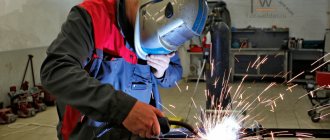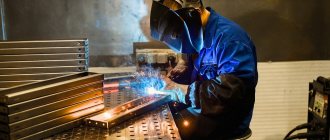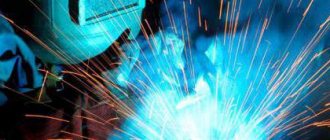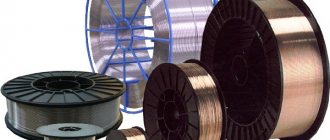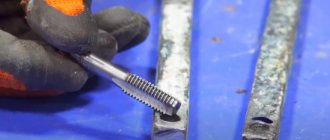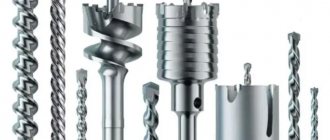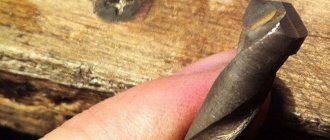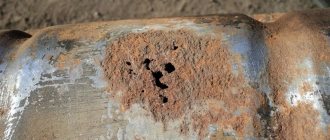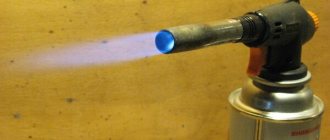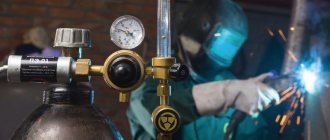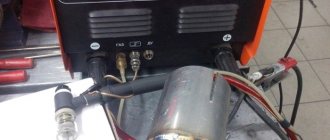What the article is about:
Can a carbon dioxide cylinder for a semi-automatic machine explode?
For semi-automatic welding, carbon dioxide or its mixture is used. According to the principle of operation, this is the same as gas welding, but only using a welding arc.
Everything would be fine, but carbon dioxide cylinders are dangerous to handle. If stored, transported or used incorrectly, the cylinder may explode.
And although carbon dioxide does not have a toxic composition, it is under high pressure in the cylinder. This is precisely why there is a great danger of an explosion if the cylinder breaks into pieces.
Types of gases
Gases used in welding are divided into active and inert, among the active there are reactive and neutral. Moreover, the active gas can be reactive under some conditions and types of welding, and neutral under others.
All of them are pumped into special welding cylinders. Before ordering gas for work, you should familiarize yourself with the types of standard markings, the possibility of subsequent filling of cylinders with welding mixture, and their equipment.
All gases are pumped into cylinders under pressure . Therefore, containers are made of steel that does not have seams. Only at a pressure less than 3 MPa can gas containers be welded or have a seam.
In welding practice, such types are not found. Gases for welding are supplied only in cylinders without seams with special shut-off valves. Fundamentally different valves are designed for different gases.
Cylinders with gaseous flammable hydrocarbons - acetylene, propane, butane and others - are equipped with valves with left-hand threads.
Cylinders with all other gases, including oxygen, nitrogen, carbon dioxide and inert gases, are equipped with valves with right-hand threads.
The difference in the directions of rotation of the valve eliminates the possibility of accidental errors, accidents during welding or other use of gas.
Propane and propane-butane mixtures
Propane C3H8 and butane C4H10 are representatives of petroleum hydrocarbon gases, colorless, with high density. They are a by-product of natural gas production. At elevated pressure and low temperature they are liquid. To avoid possible leakage, special strong-smelling substances - odorants - are added to them.
Butane is characterized by a greater heat-generating ability compared to propane, however, it is capable of gas formation at higher temperatures, so it cannot be used at temperatures below -0.5°C. Mixtures with a predominance of propane can be used at ambient temperatures down to -25°C.
Cylinders for welding with propane and propane-butane mixtures are used for welding work on metal structures, cutting scrap metal, blank production, in the manufacture of greenhouses, garages, pipes and other structures. In addition, you should buy gas cylinders for seasonal heating of premises, heating water, and preparing food in country or camping conditions.
Coloring
For safety purposes, strictly defined coloring of containers and inscriptions on it have been introduced. The gases most commonly used in cooking are color coded as follows:
- The highly purified argon cylinder is gray in color and has a green inscription on it. The black cylinder with technical argon has a blue inscription. There is also so-called raw argon with its own markings. This gas is not used in welding;
- carbon dioxide cylinders are painted black, the inscription on them is in yellow;
- oxygen cylinders for welding are always blue, and the inscriptions on them are black. Both medical and technical grades of gas are colored this way. In medicine, oxygen is used very often. It is transported on trolleys, then, if necessary, the cylinder is installed in a special case;
- containers containing acetylene, which is very popular in welding, are black in color. Acetylene explodes very easily. Therefore, it is not pumped into empty volumes, but containing special fillers with a large number of pores. This filling method significantly reduces the likelihood of explosions.
It is useful for novice welders to remember the color coding of gases on the domestic market. Do not be surprised if the coloring on imported products is different. International labeling is somewhat different from domestic labeling.
Can a carbon dioxide cylinder for a semi-automatic machine explode?
From time to time, the gas pressure in the carbon dioxide cylinder changes. Everything here largely depends on the ambient temperature. From a liquid state, carbon dioxide turns into a gas, and vice versa.
The most common cause of a carbon dioxide cylinder explosion is failure to operate the cylinders. Sometimes the valve is not closed tightly enough, and sometimes the reason is a sharp temperature change.
That is why, when bringing in a cylinder of carbon dioxide in winter, at subzero temperatures, you must give time to equalize the pressure inside. To do this, it is enough to keep the gas cylinder indoors for several hours.
Also, old and no longer suitable welding cylinders can cause an explosion. Over time, high pressure causes microcracks to form in the walls of the cylinder, which can become even larger if the body is slightly damaged.
Stability elements and volume
A cap must be attached to the top of all cylinders. It protects the valve from accidental damage during transportation. A square-shaped base is tightly fitted onto the lower part.
It allows you to steadily place the container in a vertical position, which is important when welding. During operation, you can move the cylinder along with the semi-automatic welding machine on a special trolley. This is a convenient method for maintaining a welding spot in any work area.
Containers from 10 liters to 40 liters are available for sale. It seems tempting to purchase one for smaller volume welding. Its price is less, but after using gas, refilling a new one will not be so easy.
Most gas stations are equipped to fill 40 liters. The exception is carbon dioxide. Due to the fact that it is pumped into fire extinguishers, the capabilities of gas stations allow filling small volumes.
Oxygen or nitrogen for cutting metal?
Oxygen cutting is the cheapest. Nitrogen cutting is much more expensive, but when processing almost all metals except ferrous metals, we use nitrogen if we want to preserve the properties of the metal.
You CANNOT cut stainless steel with oxygen . If we cut it with oxygen, the material will essentially burn, because combustion is nothing more than oxidation at high temperature, and oxygen is a combustion catalyst. Thus, we make rust from stainless steel, oxidize it, that is, we simply remove all its stainless properties.
And nitrogen is a non-flammable gas, it is inert, nothing burns in it, it performs another function - it protects the metal from oxidation, cools it and removes combustion products from the cut zone.
Ferrous metals are usually cut with oxygen.
Chernukha can also be cut with nitrogen, but this will be too expensive and unprofitable, and since it does not have stainless properties, there is no point in preserving them.
One more nuance - we use nitrogen to cut everything except titanium , which during laser cutting reacts with nitrogen, crumbles, and loses its structure and properties. To cut titanium you need argon .
Gearbox
To work with any gas you need a reducer. There are models that simply show the pressure in the cylinder and with the function of regulating the gas flow.
The latter types are called regulators. They are adapted to a specific gas, painted in accordance with the color of the cylinder. There are regulators with dial scales and rotameters on sale.
If you plan to carry out argon arc welding, you need to take a regulator with two rotameters. When working with stainless steel, you need air blowing from the reverse side, which only this regulator model can control.
In other situations, a dial regulator is quite suitable, which also costs less. Practitioners consider the switch model to be more economical. If used correctly, it allows you to avoid pressure release at the beginning of work. On regulators with rotators, pressure release at first is almost inevitable. This is accompanied by some gas losses.
All regulators have gaskets made of inert polymers. Gas contamination from contact with them is absolutely excluded. When welding you have to use different gases. For such production applications, it is advisable to have regulators suitable for several types of threads.
Gas cutting machines
Gas cutting machines are divided into two classes:
- stationary _ This is powerful, high-performance equipment, the workpieces for which are delivered by special vehicles;
- portable _ These are small mobile units (massive ones are installed on self-propelled carts), the movement of which is carried out using: a spring mechanism;
- gas turbine;
- electric motor.
To use such a machine, it must be installed directly on the workpiece being processed (pipe, sheet, etc.) and directed in the desired direction (along a flexible copier, guides, etc.).
Models of both classes consist of the following main components:
- carrier. This is the “skeleton” of the unit on which the actuators and auxiliary mechanisms are mounted. For stationary machines, the “skeleton” is mounted on a powerful base;
- cutter. Powerful machines with high labor productivity are equipped with several cutters;
- leading. This unit is a drive mechanism, it is the source of movement of the entire machine and the workpiece being processed;
- Remote Control. From here all processes occurring on a gas cutting machine are controlled and monitored. There are types of control: manual;
- using CNC.
Portable gas pipe cutting machine “CG2-11”. East. https://www.mossvarka.ru/catalog/mashiny_gazovoy_rezki/.
The following models are very popular:
- portable gas pipe cutting machine model “CG2-11” brand “ZAO NPO “Vector” (Belarus);
- thermal cutting machine model “Kometa” brand “SPICOM” Barnaul.
Safety
The peculiarity of the domestic mentality is the tendency to save money and ignore many regulatory requirements. When it comes to welding equipment, neglecting safety rules can have serious consequences.
This is especially true for the permissible periods of use of cylinders. They must be specified by the manufacturer. If suddenly this information is not available, then the maximum period of operation is 20 years.
An examination of the condition of ordinary cylinders with a volume of up to 50 liters is not carried out. For larger volumes, certification can be carried out. It is strictly forbidden to exceed the maximum period. All models produced before 1997 that have not passed certification can be safely scrapped.
The purchase of gas cylinders for welding should be taken very seriously. It is best to find a reputable supplier, make sure that permits are available, and check the quality of the labeling and all accompanying information. After this, you can safely place your order.
Service and repair of a metal laser machine
Many people can sell metal cutters, but not everyone has the same experience and knowledge as our managers and service employees.
Perhaps this article contained many terms that were unclear to you, do not be alarmed, we will clearly tell you about all the nuances and teach you how to operate the machine correctly. Our training lasts three days, during which time you will learn everything you need about the structure of the machine and its maintenance, we will teach you how to select settings for different types of materials of different thicknesses and show you how to work with cutting modes that simplify your work and help save time and materials .
We have successful experience working with various industries and therefore can teach you a lot, share our experience and give you unique advice on how to optimally set up your production.
